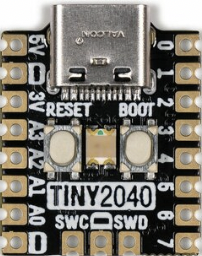Pimoroni Tiny2040
The Tiny2040 is a general purpose RP2040 board supplied by Pimoroni.

The Pimoroni Tiny 2040 has two buttons (RESET and BOOT) allowing to boot from ROM without disconnecting the device.
See the Pimoroni website for information about the Pimoroni Tiny 2040.
Features
RP2040 microcontroller chip
Dual-core ARM Cortex M0+ processor, flexible clock running up to 133 MHz
264kB of SRAM, and 2MB or 8MB of on-board Flash memory
Castellated module allows soldering direct to carrier boards
USB Host and Device support via type C connector
Low-power sleep and dormant modes
Drag & drop programming using mass storage over USB
12 multi-function GPIO pins
2× SPI, 2× I2C, 2× UART, 3× 12-bit ADC, 16× controllable PWM channels
Accurate clock and timer on-chip
Temperature sensor
Accelerated floating point libraries on-chip
8 × Programmable IO (PIO) state machines for custom peripheral support
Pin Mapping
Pads numbered anticlockwise from USB connector.
Pad |
Signal |
Notes |
|---|---|---|
1 |
VBUS |
Connected to USB +5V |
2 |
Ground |
|
3 |
3V3 |
Out to peripherals |
4 |
GPIO29 |
ADC3 |
5 |
GPIO28 |
ADC2 |
6 |
GPIO27 |
ADC1 |
7 |
GPIO26 |
ADC0 |
8 |
Ground |
|
9 |
GPIO7 |
|
10 |
GPIO6 |
|
11 |
GPIO5 |
|
12 |
GPIO4 |
|
13 |
GPIO3 |
|
14 |
GPIO2 |
|
15 |
GPIO1 |
Default RX for UART0 serial console |
16 |
GPIO0 |
Default TX for UART0 serial console |
Power Supply
The Raspberry Pi Pico can be powered via the USB connector, or by supplying +5V to pin 1.
The Raspberry Pi Pico chip run on 3.3 volts. This is supplied by an onboard voltage regulator.
Installation & Build
For instructions on how to to install the build dependencies and create a NuttX image for this board, consult the main RP2040 documentation.
Configurations
All configurations listed below can be configured using the following command in
the nuttx directory (again, consult the main RP2040 documentation):
$ ./tools/configure.sh pimoroni-tiny2040:<configname>
composite
NuttShell configuration (console enabled in UART0, at 115200 bps) with support for
CDC/ACM with MSC USB composite driver. conn command enables the composite
device.
gpio
NuttShell configuration (console enabled in UART0, at 115200 bps) with GPIO examples.
GPIO |
Function |
|---|---|
GPIO18 |
Onboard RGB LED (red, out) |
GPIO19 |
Onboard RGB LED (green, out) |
GPIO20 |
Onboard RGB LED (blue, out) |
GPIO23 |
Onboard BOOT button (user) |
No interrupt pin configured.
nsh
Basic NuttShell configuration (console enabled in UART0, at 115200 bps).
nsh-flash
Basic NuttShell configuration (console enabled in UART0, at 115200 bps with SMART flash filesystem.
nshsram
NuttShell configuration (console enabled in UART0, at 115200 bps) with interrupt vectors in RAM.
smp
Basic NuttShell configuration (console enabled in UART0, at 115200 bps) with both ARM cores enabled.
spisd
NuttShell configuration (console enabled in UART0, at 115200 bps) with SPI SD card support enabled.
SD card slot |
Pimoroni Tiny 2040 |
|---|---|
DAT2 |
Not connected |
DAT3/CS |
GP5 (SPI0 CSn) (Pin 11) |
CMD /DI |
GP7 (SPI0 TX) (Pin 9) |
VDD |
3V3 OUT (Pin 3) |
CLK/SCK |
GP6 (SPI0 SCK) (Pin 10) |
VSS |
GND (Pin 2 or 8) |
DAT0/DO |
GP4 (SPI0 RX) (Pin 12) |
DAT1 |
Not connected |
Card hot swapping is not supported.
usbmsc
NuttShell configuration (console enabled in UART0, at 115200 bps) with support for USB MSC and CDC/ACM.
msconn and sercon commands enable the MSC and CDC/ACM devices. The MSC
support provides the interface to the SD card with SPI, so the SD card slot
connection like spisd configuration is required.
usbnsh
Basic NuttShell configuration using CDC/ACM serial (console enabled in USB Port, at 115200 bps).